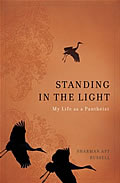Quaker Pantheism
Posted on December 30, 2013 by Amy Lenzo
Standing in the Light: My Life as a Pantheist
by Sharman Apt Russell
New York: Basic Books, 2008.
Reviewed by John Scull
 I have seldom encountered a book that reflects my worldview as clearly as Standing in the Light: My Life as a pantheist. The book is both a sort of quirky spiritual autobiography and a treatise on the history of Pantheism.
I have seldom encountered a book that reflects my worldview as clearly as Standing in the Light: My Life as a pantheist. The book is both a sort of quirky spiritual autobiography and a treatise on the history of Pantheism.
The book follows several different but interrelated threads: On a personal level, she describes her experiences as an on- and off- and on-again Quaker, her personal history living in both urban and rural New Mexico and elsewhere, and accounts of exploring and assisting with research (banding birds) in protected natural areas. Interspersed with these personal stories and reflections she gives us a clear and insightful discussion of pantheism from the early Greeks to the present.
Russell traces the history of pantheism from pre-Socratic Greeks — Thales, Anaximander, Anaximenes, Heraclitus, and Democritus – to Epicurus and the Stoics. She has a fascinating chapter on the Stoic Roman Emperor Marcus Aurelius, whom she sees as one of the first true Pantheists. Early Christianity saw Pantheism as one of the pagan competitors to be suppressed, and pantheists were persecuted for more than 1,000 years, most famously in the execution (by burning at the stake) of Giordano Bruno in 1600.
The next hero of Pantheism was Baruch Spinoza in the 17th Century. He was excommunicated by the Jewish establishment as well as rejected by both Protestants and Catholics. Spinoza attended Quaker meetings, corresponded with Margaret Fell, incorporated many Quaker perspectives in his work, and his writings had some influence on Quakerism. But Spinoza was even more blunt and plain-spoken than the Quakers and their ideas were not nearly radical enough for Spinoza.
Next in the Pantheist history were the Romantic poets, Goethe, Coleridge, Wordsworth, Blake, and others. Then came the Transcendentalists Ralph Waldo Emerson and Henry David Thoreau, the poet Walt Whitman, and the naturalist John Muir. More controversially, she suggests that D.H. Lawrence and Virginia Woolf were also Pantheists.
Her history of Pantheism ends with a quote from poet Robinson Jeffers, a summary of contemporary Pantheism:
“I believe that the universe is one being, all its parts are different expressions of the same energy, and they are all in communication with each other, therefore parts of one organic whole. … The whole is in all its parts so beautiful, and is felt by me so intensely in earnest, that I am compelled to love it and to think of it as divine.”
Russell wraps up the discussion of pantheism by relating it to Daoism and Buddhism and a number of other contemporary writers who share her views: Fritjof Capra, Stephen Harding, George Sessions, Barbara McClintock, Ursula Goodenough, Thomas Berry, and Annie Dillard. At the end of the spiritual journey described in the book she realizes that when she is in the natural world she is in the mind and body of God, and she returns to her Quaker meeting with this new understanding.
This very readable book puts us in touch with scientific pantheism, a spiritual tradition that brings together ecology (both deep and scientific) and mysticism. Sharman beautifully weaves together her personal journey, the history of these ideas, and the ecological crisis in the modern world.

